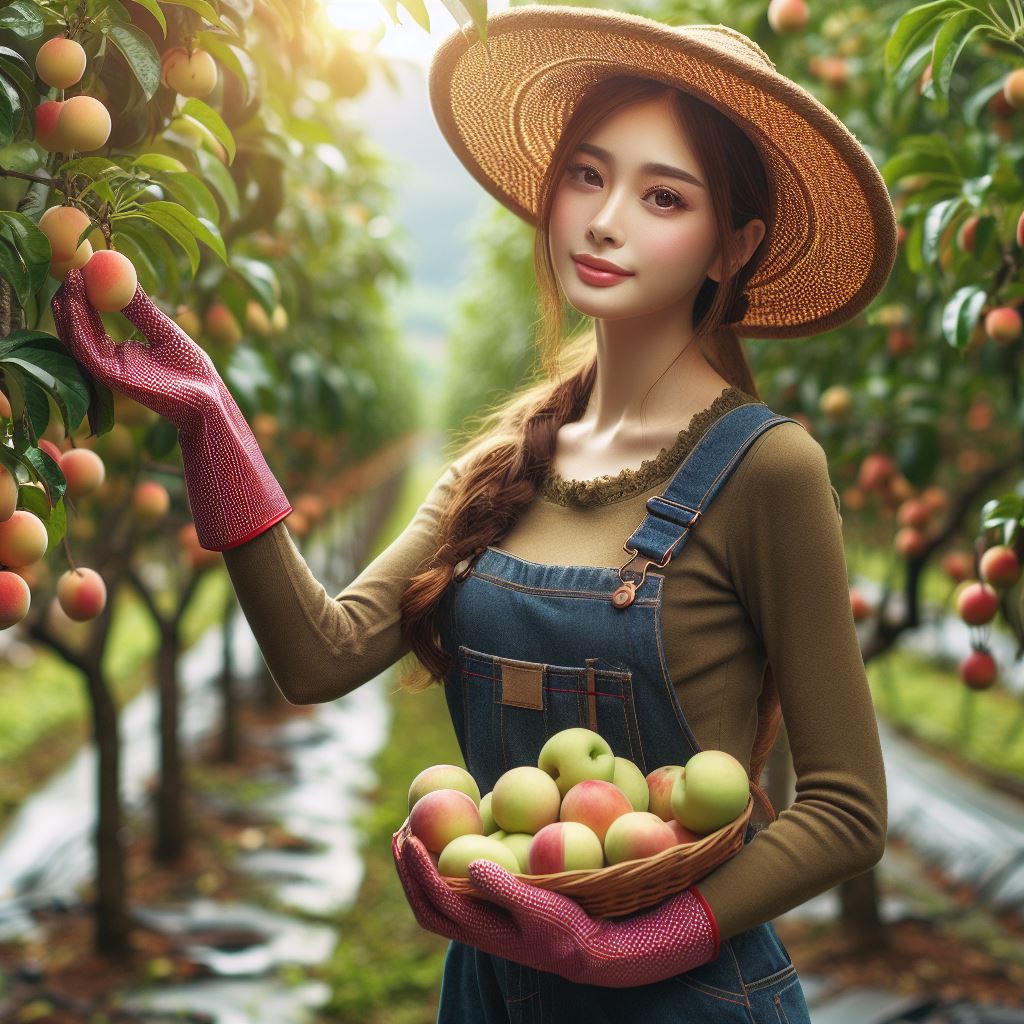Orchard Heirs: Fruit Farming Through Time
Last Updated on March 1, 2024
Introduction
Orchard heirs fruit farming through time, orchards have long been integral to agriculture, not only for their provision of nutritious fruits but also for their contributions to environmental sustainability.
Orchards offer more than just food; they provide habitats for wildlife, help prevent soil erosion, and contribute to the overall aesthetic appeal of landscapes.
In this blog post, we’ll explore the captivating narrative of fruit farming, from its ancient roots to its modern-day practices.
Fruit farming has undergone significant transformations over time, influenced by technological advancements, shifts in consumer preferences, and changes in environmental conditions.
By examining the evolution of fruit farming, we gain insights into the ingenuity of past civilizations, the challenges they faced, and the innovations they developed to overcome them.
We’ll discover how ancient orchardists cultivated fruits with rudimentary tools and techniques, laying the groundwork for today’s sophisticated agricultural practices.
Moreover, we’ll uncover the societal and cultural significance of fruit farming throughout history.
From the symbolic importance of certain fruits in religious rituals to the economic impact of global fruit trade, fruit farming has left an indelible mark on human civilization.
Through this exploration, we’ll gain a deeper appreciation for the resilience and adaptability of orchard heirs—those who have inherited and sustained the tradition of fruit farming over generations.
Their dedication to preserving orchards as vital components of our agricultural heritage is a testament to the enduring value of fruit cultivation.
Join us on a journey through time as we unravel the rich tapestry of orchard history and celebrate the timeless beauty and bounty of fruit farming.
Historical Background of Fruit Farming
The origins of fruit farming can be traced back to ancient civilizations
- Fruit cultivation first began in Mesopotamia, where figs, dates, and pomegranates were grown.
- Ancient Egyptians also practiced fruit farming, growing grapes, melons, and figs along the Nile River.
- In China, fruit farming had its roots during the Shang Dynasty, with peaches, plums, and citrus fruits.
These early civilizations used various cultivation techniques to ensure successful fruit farming
- They developed irrigation systems to provide water to the fruit trees and plants.
- Some civilizations used grafting to improve the quality and variety of fruits.
- Pruning and training techniques were employed to shape and support fruit trees.
The spread of fruit farming occurred as civilizations expanded and interacted with one another
- Trade routes played a significant role in the dissemination of fruit farming practices.
- Through trade, fruit trees and seeds were exchanged, allowing different regions to cultivate new varieties.
- Mediterranean civilizations, such as the Greeks and Romans, greatly influenced fruit farming in Europe.
- The colonization of the Americas introduced European fruit varieties to the New World.
Overall, the historical background of fruit farming showcases the rich heritage and global significance of this agricultural practice.
Read: Dairy Farmer’s Journey to Sustainability
The Rise of Orchards
The transition from wild fruit trees to intentional orchards
In the early history of fruit farming, humans relied on wild fruit trees for sustenance.
However, as civilizations developed, people began to intentionally cultivate orchards for a more reliable food source.
This transition from wild fruit trees to intentional orchards was driven by the desire for greater control and variety in fruit production.
In ancient times, the development of grafting techniques played a crucial role in the growth of orchards.
Grafting involves joining the tissues of two different plants to create a new variety with desired traits.
By grafting, farmers were able to reproduce specific varieties of fruits, ensuring consistent quality and taste.
This technique allowed for the propagation of orchard trees with desirable characteristics, such as resistance to diseases or pests.
The development of grafting techniques and its impact on orchard growth
With the development of grafting, orchards began to expand rapidly, as the process allowed for the efficient reproduction of superior fruit trees.
During different time periods, a variety of fruits have been commonly grown in orchards.
In ancient times, popular fruits included apples, pears, and figs.
Throughout the Middle Ages, orchards often contained a wide array of fruits, including peaches, plums, and cherries.
The Renaissance period witnessed the cultivation of exotic fruits, such as oranges, lemons, and bananas in European orchards.
As horticultural knowledge expanded during the 18th and 19th centuries, the variety of fruits grown in orchards grew even more diverse.
Apples, pears, peaches, plums, cherries, and apricots became staples in orchards, varying by region and climate.
In modern times, the cultivation of fruit orchards has become highly specialized and varied, reflecting global demand.
Today, in addition to the traditional fruits, orchards may include citrus fruits, berries, avocados, and other exotic varieties.
The rise of orchards has transformed fruit farming into a sophisticated industry, meeting the demands of an expanding population.
Orchards have not only provided a consistent supply of fresh fruit but have also contributed to cultural traditions and local economies.
The intentional cultivation of orchards, supported by grafting techniques, has enabled humans to enjoy a diverse array of fruits throughout history.
This evolution from wild fruit trees to intentional orchards has had a profound impact on the availability and variety of fruits around the world.
As orchard heirs, we continue to build upon the knowledge of our ancestors to cultivate thriving orchards for generations to come.
Read: Maine Lobsterman’s Sustainable Practices
Challenges Faced by Orchard Heirs
Managing orchards over generations presents numerous difficulties.
Disease control, climate change, and market competition are major concerns.
- Disease control poses a constant challenge for orchard heirs. Pests and pathogens threaten crop health and yield.
- Climate change exacerbates existing challenges. Erratic weather patterns disrupt growing seasons and increase the risk of extreme events.
- Market competition intensifies with globalization. Orchard heirs must adapt to changing consumer preferences and market demands.
Despite these challenges, modern technology and practices offer solutions:
- Advanced monitoring systems help detect diseases early, enabling timely intervention and minimizing crop losses.
- Precision agriculture techniques optimize resource use and minimize environmental impact, enhancing orchard sustainability.
- Climate-resilient crop varieties are developed through genetic engineering and selective breeding, ensuring resilience to changing climatic conditions.
- Diversification strategies such as agritourism and value-added products help orchard heirs tap into new revenue streams and mitigate market risks.
- Digital marketing platforms provide direct access to consumers, reducing dependency on traditional distribution channels and improving profitability.
- Collaboration and knowledge-sharing networks facilitate the exchange of best practices and innovative solutions among orchard heirs.
In fact, while orchard heirs face significant challenges, modern technology and practices offer viable solutions.
By embracing innovation and adopting sustainable strategies, orchard heirs can overcome obstacles and thrive in the ever-evolving agricultural landscape.
Read: Sowing Hope: Farming in Changing Climes

Innovations in Fruit Farming
Innovation has played a crucial role in the evolution of fruit farming throughout history.
In this section, we will explore some of the key advancements that have shaped the industry.
Introduction of New Fruit Varieties
- The breeding and hybridization of new fruit varieties have revolutionized the fruit farming industry.
- Through selective breeding, farmers have been able to develop fruits with improved taste, size, and disease resistance.
- Hybridization has allowed for the creation of fruits with unique characteristics, combining the best traits from different species.
- These new varieties have not only expanded consumer choices but also increased yields and profitability for farmers.
- The development of new apples, such as the Honeycrisp and Pink Lady, showcases the success of these breeding and hybridization techniques.
Advancements in Pest and Disease Management Techniques
- Pest and disease management techniques have undergone significant advancements in recent years.
- Integrated Pest Management (IPM) strategies have been implemented to minimize the use of pesticides.
- IPM involves the monitoring and prevention of pests through cultural practices and the use of biological control methods.
- Biological control techniques, such as the use of beneficial insects, have proven effective in reducing pest populations.
- Additionally, advancements in genetic engineering have led to the development of disease-resistant varieties.
- These varieties are less susceptible to common fruit diseases, reducing the need for chemical treatments.
Use of Technology in Orchard Management
- Technology has greatly enhanced orchard management practices, improving efficiency and reducing costs.
- Drones have become an invaluable tool for monitoring orchards, providing aerial views and detecting areas of concern.
- Through drone imagery, farmers can identify pest infestations, nutrient deficiencies, or irrigation issues.
- Furthermore, automated irrigation systems ensure precise water application, optimizing resource utilization.
- Weather and soil sensors connected to wireless networks provide real-time data, enabling farmers to make informed decisions.
- Besides, specialized software aids in crop planning, inventory management, and yield forecasting.
In short, the innovations in fruit farming have had a profound impact on the industry’s growth and sustainability.
The introduction of new fruit varieties through breeding and hybridization, advancements in pest and disease management techniques, and the use of technology in orchard management have revolutionized the way fruits are grown.
These innovations have not only improved the quality and yield of fruits but also made fruit farming more sustainable and economically viable.
Read: Fencing Fields: A Sheep Farmer Diary
Sustainability and Fruit Farming
Sustainable fruit farming practices play a crucial role in protecting and preserving our environment.
These practices focus on minimizing the negative impact on the ecosystem and ensuring the long-term health and productivity of fruit orchards.
Importance of Sustainable Fruit Farming
- Protects soil quality and prevents erosion, maintaining the land’s productive capacity.
- Minimizes the use of synthetic chemicals, reducing pollution and promoting healthier ecosystems.
- Promotes biodiversity by providing habitats for beneficial insects, birds, and animals.
- Conserves water by implementing efficient irrigation techniques and reducing water usage.
- Preserves the health and safety of farm workers by minimizing exposure to harmful pesticides.
Techniques like Organic Farming, Integrated Pest Management, and Water Conservation
Organic farming is a sustainable approach that avoids the use of synthetic fertilizers, pesticides, and genetically modified organisms.
It promotes natural pest control, soil fertility, and biodiversity.
Integrated Pest Management (IPM) is another technique that focuses on using a combination of strategies to manage pests effectively.
These strategies include biological control with beneficial insects, crop rotation, and regular monitoring to reduce the need for chemical pesticides.
Water conservation is of utmost importance in fruit farming.
By employing drip irrigation techniques, farmers reduce water wastage and ensure that water is efficiently delivered directly to the plant’s roots.
Role of Orchard Heirs in Preserving Biodiversity and Promoting Sustainability
- Orchard heirs play a vital role in preserving biodiversity by maintaining the genetic diversity of fruit varieties.
- They promote sustainable farming practices by adopting and implementing environmentally friendly techniques.
- By practicing crop rotation and intercropping, orchard heirs reduce the risk of disease and pests, thereby minimizing the need for chemical interventions.
- Orchard heirs also focus on preserving heirloom and heritage fruit varieties, preventing the loss of valuable genetic material.
- They educate and collaborate with other farmers, sharing knowledge and promoting sustainable farming practices.
In general, sustainable fruit farming practices are crucial for the environment’s well-being and the long-term viability of fruit orchards.
Techniques like organic farming, integrated pest management, and water conservation help preserve biodiversity, reduce pollution, and promote healthier ecosystems.
Orchard heirs, through their dedication to sustainability, play a vital role in preserving our natural resources and ensuring a sustainable future for fruit farming.
See Related Content: Eco-Warrior Farmers: Youth Leading Change
Conclusion
This blog post highlighted the significant role of orchard heirs in fruit farming throughout history.
The key points discussed revolved around the continuation and advancement of fruit farming, as well as the cultural and economic contributions it has made over time.
Orchard heirs play a crucial role in preserving and expanding fruit farming traditions, passing down knowledge and expertise from one generation to another.
Their dedication and commitment ensure the continuity of this vital agricultural practice.
Furthermore, the significance of orchard heirs cannot be understated in the development and innovation of fruit farming techniques.
They contribute to advancements in technology, breeding practices, and pest management, resulting in higher yields and improved fruit quality.
It is important to appreciate the legacy of fruit farming, as it goes beyond mere sustenance.
Fruit farming has shaped cultures, influenced cuisines, and fostered economic growth.
The diverse varieties of fruits cultivated over the years have become integral parts of our diets and traditions.
By recognizing the cultural and economic contributions of fruit farming, readers can develop a deeper appreciation for this agricultural heritage.
Understanding the efforts of orchard heirs in preserving and advancing fruit farming should inspire us all to support and celebrate this timeless and valuable practice.


